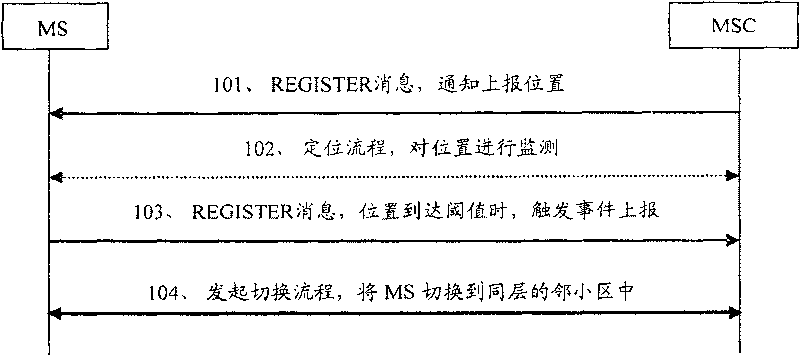Small-zone switching-over method
A cell handover and inter-cell technology, applied in electrical components, wireless communications, etc., can solve problems such as high network coverage costs, large location changes, and inability to accurately determine the location of MSs, so as to improve handover sensitivity and success rate, reduce The area covered by cell overlap and the effect of reducing the area covered by cell overlap
- Summary
- Abstract
- Description
- Claims
- Application Information
AI Technical Summary
Problems solved by technology
Method used
Image
Examples
Embodiment 1
[0045] Embodiment 1: Handover based on location in GSM network.
[0046] This embodiment is applicable to networks with linear coverage, such as GSMR networks.
[0047] See figure 1 , figure 1 It is a schematic diagram of the location-based handover process in the GSMR network. Such as figure 1 As shown, the implementation process of handover based on location in the GSMR network is as follows:
[0048] Step 101: Mobile Switching Center (MSC, Mobile Switch Center) sends a message to the MS through a task registration (REGISTER) message, carrying a location threshold in the message, and notifying the MS to report when reaching the specified location threshold, which is pre-set by the MSC. The location threshold includes one location point or two location points, and one location point is represented by a latitude and longitude. In practical applications, if a cell has only one neighbor cell, you can set a location threshold that includes only one location point for the MS ...
Embodiment 2
[0060] Embodiment 2: Handover based on location and moving direction in GSM network.
[0061] When there are multiple adjacent cells around a cell, sometimes it is difficult to judge the target cell for handover only by the position of the MS. When making a handover decision, combined with the MS's moving direction method, sometimes frequent handovers can be avoided. For example, when the MS reaches the location threshold, but it is determined to move to the cell according to its moving direction, the MS may not be handed over, and the MS is still determined by the MS. The cell to which the MS originally belongs provides services.
[0062] Embodiment 2 is applicable to networks with linear coverage, or networks with non-linear coverage and only one layer of cells.
[0063] See image 3 , image 3 It is a schematic diagram of the handover process based on location and moving direction in the GSM network. Such as image 3 As shown, the implementation process of switching ba...
Embodiment 3
[0077] Embodiment 3: Handover based on location and moving speed in GSM network.
[0078] In addition to the method of handover based on the position of the MS or based on the position and direction of movement of the MS, the handover decision can also be made in combination with the mobile rate of the MS. At this time, the MSC can determine the target cell for handover according to the mobile rate of the MS. In a network covered by layer networks, it can be judged according to the moving speed of the MS whether to switch it to an adjacent cell on a different layer or to an adjacent cell on the same layer, and when making a decision based on the moving speed of the MS, it can be According to the speed of the MS's moving speed, set the position threshold for the MS far or close to the edge of the cell.
[0079] See Figure 7 , Figure 7 It is a schematic diagram of the handover process based on position and moving speed, that is, moving direction and moving speed in the GSM n...
PUM
 Login to View More
Login to View More Abstract
Description
Claims
Application Information
 Login to View More
Login to View More - R&D
- Intellectual Property
- Life Sciences
- Materials
- Tech Scout
- Unparalleled Data Quality
- Higher Quality Content
- 60% Fewer Hallucinations
Browse by: Latest US Patents, China's latest patents, Technical Efficacy Thesaurus, Application Domain, Technology Topic, Popular Technical Reports.
© 2025 PatSnap. All rights reserved.Legal|Privacy policy|Modern Slavery Act Transparency Statement|Sitemap|About US| Contact US: help@patsnap.com



